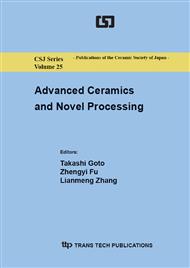[1]
Y. Zhou, K. Hirao, K. Watari, Y. Yamauchi, S. Kanzaki, Thermal conductivity of silicon carbide densified with rare-earth oxide additives, J. Eur. Ceram. Soc. 24 (2004) 265-270.
DOI: 10.1016/s0955-2219(03)00236-x
Google Scholar
[2]
A.M. Kueck, D.K. Kim, Q.M. Ramasse, L.C. De Jonghe, R.O. Ritchie, Atomic-resolution imaging of the nanoscale origin of toughness in rare-earth doped SiC, Nano Lett. 8 (2008) 2935-2939.
DOI: 10.1021/nl8017884
Google Scholar
[3]
Y.-W. Kim, S.H. Lee, T. Nishimura, M. Mitomo, Heat-resistant silicon carbide with aluminum nitride and scandium oxide, Acta Mater. 53 (2005) 4701-4708.
DOI: 10.1016/j.actamat.2005.07.002
Google Scholar
[4]
K.-Y. Lim, Y.-W. Kim, T. Nishimura, W.S. Seo, High temperature strength of silicon carbide sintered with 1 wt.% aluminum nitride and lutetium oxide, J. Eur. Ceram. Soc. 33 (2013) 345-350.
DOI: 10.1016/j.jeurceramsoc.2012.09.005
Google Scholar
[5]
Y.-W. Kim, K.J. Kim, H.C. Kim, N.H. Cho, K.-Y. Lim, Electrodischarge-machinable silicon carbide ceramics sintered with yttrium nitrate, J. Am. Ceram. Soc. 94 (2011) 991-993.
DOI: 10.1111/j.1551-2916.2011.04419.x
Google Scholar
[6]
K.J. Kim, K.-Y. Lim, Y.-W. Kim, Control of electrical resistivity in silicon carbide ceramics sintered with aluminum nitride and yttria, J. Am. Ceram. Soc. 96 (2013) 3463-3469.
DOI: 10.1111/jace.12498
Google Scholar
[7]
G. A. Slack, Thermal conductivity of pure and impure silicon, silicon carbide, and diamond, J. Appl. Phys. 35, (1964) 3460-3466.
DOI: 10.1063/1.1713251
Google Scholar
[8]
Y. Takeda, Development of high-thermal-conductive SiC ceramics, Ceram. Bull. 67 (1988) 1961-1963.
Google Scholar
[9]
Y.-W. Kim, K.-Y. Lim, W.S. Seo, Microstructure and thermal conductivity of silicon carbide with yttria and scandia, J. Am. Ceram. Soc. (2013) in press.
DOI: 10.1111/jace.12737
Google Scholar
[10]
K. Watari, H. Nakano, K. Sato, K. Urabe, K. Ishizaki, S. Cao, K. Mori, Effect of grain boundaries on thermal conductivity of silicon carbide ceramic at 5 to 1300 K, J. Am. Ceram. Soc. 86 (2003) 1812-1814.
DOI: 10.1111/j.1151-2916.2003.tb03563.x
Google Scholar
[11]
Y.-W. Kim, M. Mitomo, J. Emoto, J.G. Lee, Effect of initial α-phase content on microstructure and mechanical properties of sintered silicon carbide, J. Am. Ceram. Soc. 81 (1998) 3136-3140.
DOI: 10.1111/j.1151-2916.1998.tb02748.x
Google Scholar


